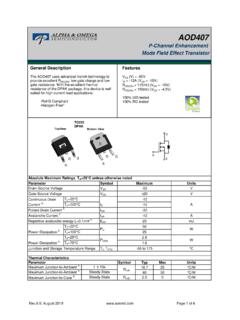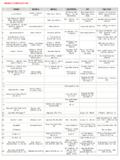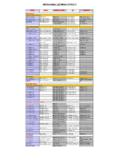Transcription of The Cross-Sectional Dispersion of Stock Returns, …
1 The Cross-Sectional Dispersion of Stock Returns, alpha and the Information Ratio Larry R. Gorman Associate Professor of Finance California Polytechnic State University San Luis Obispo, CA 93407 / Steven G. Sapra Portfolio Manager, Analytic Investors, LLC 555 West Fifth Street, 50th Floor, Los Angeles, CA 90013 and Center for Neuroeconomic Studies / Robert A. Weigand* Professor of Finance and Brenneman Professor of Business Strategy Washburn University School of Business 1700 SW College Ave., Topeka, KS 66621 / _____ Abstract Both the Cross-Sectional Dispersion of Stock returns and the VIX provide forecasts of alpha Dispersion across high- and low-performing portfolios of stocks that are statistically and economically significant. These findings suggest that absolute return investors can use Cross-Sectional Dispersion and time-series volatility as signals to improve the tactical timing of their alpha -focused strategies.
2 Because active risk increases by a greater amount than alpha , however, high return Dispersion /high VIX periods are followed by slightly lower information ratio Dispersion . Therefore, relative return investors who keep score in an information ratio framework are unlikely to find return Dispersion useful as a signal regarding when to increase or decrease the activeness of their portfolio strategies. JEL Classification: G11, G17 Keywords: alpha , Information Ratio, Cross-Sectional Dispersion , Volatility, VIX _____ January 2010 Forthcoming in The Journal of Investing * Corresponding author. Address correspondence to Robert A. Weigand, , Professor of Finance and Brenneman Professor of Business Strategy, Washburn University School of Business, 1700 SW College Ave.
3 , Topeka, Kansas, USA, 66621. Phone: email: The Cross-Sectional Dispersion of Stock Returns, alpha and the Information Ratio Abstract Both the Cross-Sectional Dispersion of Stock returns and the VIX provide forecasts of alpha Dispersion across high- and low-performing portfolios of stocks that are statistically and economically significant. These findings suggest that absolute return investors can use Cross-Sectional Dispersion and time-series volatility as signals to improve the tactical timing of their alpha -focused strategies. Because active risk increases by a greater amount than alpha , however, high return Dispersion /high VIX periods are followed by slightly lower information ratio Dispersion . Therefore, relative return investors who keep score in an information ratio framework are unlikely to find return Dispersion useful as a signal regarding when to increase or decrease the activeness of their portfolio strategies.
4 1 The Cross-Sectional Dispersion of Stock Returns, alpha and the Information Ratio In recent years a growing literature has emerged that focuses on the performance of active money managers, both in absolute terms and relative to industry benchmarks. The findings of these studies, which are reviewed in the next section, strongly suggest that in the aggregate, professional money managers underperform their benchmarks, and do so with surprising consistency. We provide an additional perspective on the performance of active equity managers by investigating how the Dispersion of alpha (the key measure of manager over- and underperformance) changes over time and how performance metrics such as alpha and the information ratio (IR) are affected by changes in the Cross-Sectional Dispersion of equity returns. Cross-Sectional Dispersion measures the volatility of returns around an index s mean return on the same day, week or month.
5 Gorman, Sapra and Weigand [2010] provide a theoretical framework linking the Dispersion of returns to the Dispersion of alpha . When the Dispersion of alpha is large, the high-conviction Stock selections of skilled managers will outperform their benchmark indexes by greater amounts. Therefore, any metric that accurately signals the future Dispersion of alpha is valuable to investors. Our results show that the Cross-Sectional Dispersion of equity returns provides accurate forecasts of the Dispersion of alpha over both 3-month and 1-year horizons. For example, when return Dispersion is in its highest quintile (36-90%), it identifies a 160% (annualized) difference in the median alphas of high- and low-performing portfolios of stocks over the next 3 months, vs. a 105% difference when return Dispersion is in its lowest quintile. While the 3-month forecasts of the Dispersion of alpha are more informative, the magnitude of the alpha Dispersion signals over 1-year horizons is also economically significant.
6 When 2dispersion is in its highest quintile, the spread between the median alphas for stocks in the 90th vs. 10th alpha percentile over the next year is 74%. This compares to a 53% spread when Dispersion is in its lowest quintile. Our results indicate that return Dispersion can be used as an effective alpha Dispersion signal for investors whose focus is mainly on either the long or short side, as well as investors pursuing long-short strategies. Moreover, we find that return Dispersion and the VIX (a time-series oriented volatility measure) are positively correlated, and that the VIX provides similar information regarding the future Dispersion of alpha . As reported in greater detail below, investors can observe the VIX at zero cost and infer a forecast of the overall Dispersion of equity alpha over the next 3 to 12 months, and use this information to tactically time the activeness of their portfolio strategies as alpha -capture opportunities change.
7 Our results suggest that the Dispersion and VIX signals will be most useful to investors pursuing absolute return strategies, however, as the signals are not useful for identifying economically significant changes in information ratio Dispersion . Because active risk expands (contracts) by only slightly more than alpha following periods of high (low) Dispersion or the VIX, the forecasts of information ratio Dispersion are statistically significant, but the differences in IR Dispersion across high- and low-volatility periods are too small to be economically significant. MOTIVATION AND PRIOR LITERATURE Most research into active money management concludes that the majority of managers underperform their benchmarks. The prevalence of negative alphas among mutual funds (net of expenses and trading costs) is well-documented by studies such as Elton, et al.
8 [1993], Carhart [1997] and Bogle [1998]. More recently, Standard & Poor s Indices vs. Active Funds 3(SPIVA) 2009 scorecard reports that over the period 2004-2008, 63% of large cap mutual funds, 74% of mid-cap funds and 68% of small-cap funds trailed their benchmarks. Among international mutual funds, the underperformance rates ranged between 60-90%. Davis [2001] and Ennis and Sebastian [2002] find that small-cap managers do not add alpha when returns are adjusted for risk. Malkiel [2004] argues that even predictable patterns in equity returns cannot be exploited for profit. Barras, Scalliet and Wermers [2008] use an innovative statistical method and conclude that the proportion of zero- alpha mutual funds is higher than previously thought (approximately 75% net of fees and expenses), but find that less than 1% of funds deliver alpha in a way that is consistent with manager skill.
9 Even critics of the efficient markets theory admit to a .. strong conviction that the number of genuinely skilled managers is quite small [Jaeger 2008, p. 54]. The performance of investment managers in the absolute return and hedge fund space is similarly disappointing. Malkiel and Saha [2005] conclude that hedge fund returns are .. lower than commonly supposed and that hedge funds are significantly riskier than more conventional investments. Fung, Xu and Yau [2004] also report negative average alphas for hedge funds, and Pojarliev and Levich [2008] find negative mean risk-adjusted alphas among a sample of currency managers. Writing about long-short funds, O Hara [2009] asks If managers can t beat the market, what purpose do they serve? Statman [2004] provides an interesting answer to O Hara s question with his suggestion that investors may tolerate sub-par performance because they want more from investing than the utilitarian benefits of high returns, and use their relationships with money management firms to express their social class and 4 Samuelson [2004] argues that broader use of inexpensive equity indexing would boost wealth overall and make equity investors better off.
10 French [2008] attempts to quantify this loss of wealth; he estimates that pursuing active rather than passive equity strategies caused investors average annual returns to be lower by of the total market cap of the Stock market from 1980-2006. Applying French s estimate to 2007 when the market capitalization of the Stock market approached $15 trillion investors would have paid the active money management industry $100 billion more in fees, expenses and trading costs than they received in value-added investment returns from active equity management. We add a new perspective to the active equity management debate by investigating the Dispersion of alpha in equity markets from 1981-2008, and how the Dispersion of alpha changes with market volatility. Gorman, Sapra and Weigand [2010, p. 1] discuss how a manager s ability to add value is directly tied to the Dispersion of Stock returns: Ultimately, active portfolio management requires some Dispersion of returns across stocks in order to provide a reasonable opportunity set for ranking the relative expected returns of securities.







